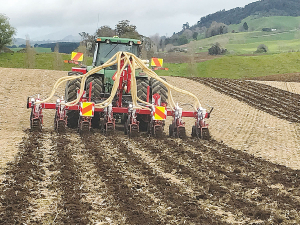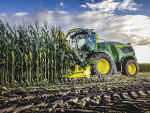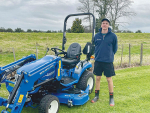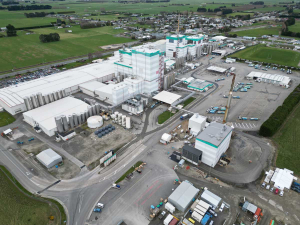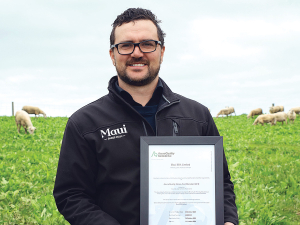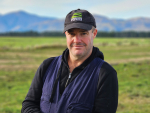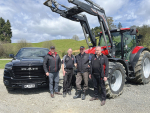Much of their Pinenui Farm is given over to forage maize production, with 125ha producing around 22 tonnes/ha off the rolling terrain during the 2021-22 season. After harvest, the area goes back to grass for winter grazing cows from local herds, fattening boner dairy cows and keeping a few sheep.
Operated by Tim Fookes and his son Simon, they have grown maize by ‘conventional’ methods for more than 40 years. However, four years ago they headed down the route of striptill cultivation and establishment.
Much of the reasoning behind the move centred on changing techniques they’d observed in Europe over several years.
“With agriculture being increasingly blamed for most of the country’s environmental issues and being expected to do its bit with regards to that environment and climate issues, we decided to move early,” says Tim.
“We had become concerned about soil erosion and run-off, so we are pleased to report that we have none of either and from a financial standpoint, we have seen no reduction in yields.”
Having made the decision to move to strip-till establishment, a major capital investment was required – not least a move to a 300hp tractor, a strip-till cultivator, planter and fertiliser application equipment. At the same time, they would need to invest in an RTK GPS guidance system, as the plan was to establish crops in the same cultivated band each year.
“When we first sat down and looked at the proposed costs of changing our system, it looked a little scary, making us wonder if indeed it was financially viable,” he told Rural News. “But we decided to look at it from a different angle, by dividing that investment by the total kilograms of dry matter we produced each season. Then the numbers appeared to stack up.”
In practice, strip-till establishment sees only 25% of a paddock cultivated compared to a conventional regime, resulting in major savings of man hours, tractor hours and fuel consumption.
“When we established maize conventionally, from pre-emergence, through cultivation, fertilising, drilling and postemergence spraying, we would typically pass over the whole paddock up to nine times,” Simon explains. “Now that whole process is achieved in five passes, but more importantly we have dropped the tractor time to grow the crop over the season from 5 hours/ha to only 45 minutes/ha.”
After winter grazing, areas to be planted are sprayed off on a whole area basis towards the end of August. Then, all the maize area is striptilled with a single pass, except for 4ha of very heavy land. It is then drilled with an 8-row Vaderstad Tempo planter by the latter part of September.
“Obviously we are at the mercy of the weather to some degree, but when we have ideal conditions, we move quickly,” Simon adds. “Typically, planting 30ha/day on the flatter land and about 20ha/day on the rolling ground.”
Drilling at a conventional 750mm (30-inch) row spacing, the farm currently takes the ‘conventional’ route with its fertiliser regime, using around 550kg urea/ha with the aim of producing a 22 tonne or better crop. Urea fertiliser is placed in the row when using the strip till cultivator, using a home-built, front-mounted bin. It is equipped with an Accord metering system and John Deere Rate Controller, with air transfer to the specially modified fertiliser coulters.
“Having used the system for the last four seasons, we haven’t seen any reduction in yield,” Tim told Rural News. “So, as we move forward we are always looking at onfarm trials to see if we can reduce fertiliser and find the point of equilibrium.”
He says a key task each season is to undertake extensive soil testing to understand the crop’s nutritional requirements. This includes deep N testing prior to planting and post-harvest, aiming to understand what nutrients have been ‘consumed’ to grow the crop.
“Given that some of the land has been growing maize nearly continuously for up to 40 years, we haven’t seen any negatives,” Simon adds. “Our worm count in both the cultivated and un-cultivated areas has been rising year on year. We aren’t experiencing any soil erosion and when it comes to harvesting, our contractor is telling us that his trucks are travelling over the ground more easily with minimal rutting, compared to traditionally established crops in the region.”
The Fookes are keen to tweak the system further, looking at yield mapping, then variable fertiliser and seeding rates.
“We are learning a little more about the system every year, even down to things like smaller seed size that seems to germinate more quickly,” Tim says. “Typically in six of seven days; probably because of their reduced water demand at germination.
“We will continue to tweak things as we move ahead, perhaps looking at trials to see if we need to move to ‘fresh’ ground every five or six years (this can be achieved by moving the strips over by 300mm) if yields start to decline.”
He says, so far, they’ve only seen benefits around time, fuel saving, soil erosion, ground stability, increased fertility and soil moisture retention.
“More importantly, we are also achieving a better work-life balance, allowing Simon to spend more time with his young family and myself with my grandchildren – so for us, it’s a win-win.”

